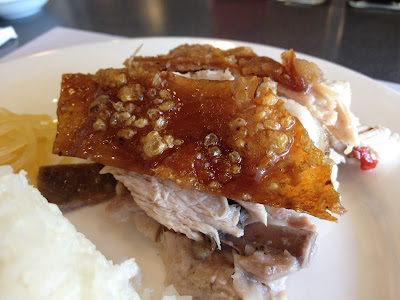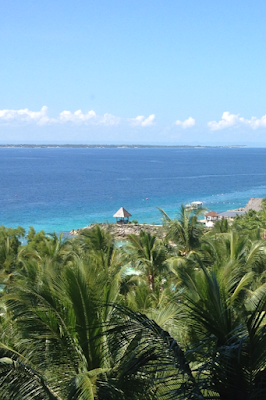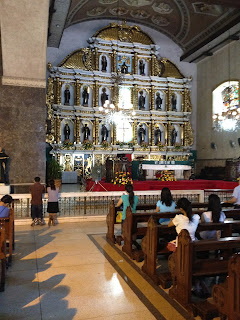I have been here for the last 5 days - primarily because of work. But if I get to travel half way around the world, then you can bet I will take time to enjoy a few extra days of sight seeing and activities.
The view from my balcony. Definately a great site to enjoy with morning coffee.
I am actually staying on a small island just across from Cebu called Lapu-Lapu. Originally designed as an "add on" to Cebu, a bridge from Cebu to Lapu-Lapu over thirty years ago enabled this smaller island to become home to a business tech park (Timex watches are assembled here), an airport - and home to great resorts along the sandy coral beaches.
Work kept me focus for most of the week. But finally, yesterday, I hired a car and "went off property" to visit the sites of Cebu.
My history friends would have focused on a different type of tour, looking at remenants of Cebu's past. This area is a famous landmark for battles between Japan, who occupied Cebu, and the historic take back of the American - Filipino army.
The most famous historical event in the area is a battle and a beheading. Ferdinand Magellan bit off more than he could chew by challening a local leader, and lost.
The Spanish receive a lesson in war.
After visiting the church, it was time to go local.
When I tell local guides I want to visit the local market, most look at my in disbelief. Most tourists go to the latest shopping mall, or the row of shops that make local handicraft. Here it is guitars.
But my long standing belief that the best way to know local culture is to go to the local food market prevails. And always serves me well.
I traveled about an hour away from my hotel to the Carbon Market. It is a marvelous market that remains a popular place for many peopel to buy fresh meat, fruit, vegetables and supplies. Farmers from the mountain come down with their items and trade. Over time, many more are going to supermarkets, but this is still the place to get the best and the freshest.
A farmer arrives with his batch of bananas, and staple here in The Philippines.
 |
| Shredding Bamboo for a Salad |
 |
| Sausage and Chorizo making at the Carbon Market in Cebu |
 |
| Stacks of Dried Fish at Carbon Market in Cebu |
 |
| Grinding cocount at the Carbon Market in Cebu Philippines |
 |
| Fresh Chickens at the Carbon Market in Cebu Philippines |
Little girl on her way to Carbon Market in Cebu Philippines
The market trip was real, raw and amazing. My driver became my security guard, as unfortunately a few bad apples want to take things that don't belong to them.
We spent much time in the building that housed the pig.
Lechón is a pork dish in several regions of the world, most specifically Spain and its former colonial possessions throughout the world. It is the national dish of the Philipines. The word lechón originated from the Spanish term leche (milk); thus lechón refers to a suckling pig that is roasted. The dish features a whole roasted pig cooked over charcoal.
Many famous dishes in Cebu feature the pig, including the famous Lechon. In fact, Anthony Bourdain on his trip to The Philippines made a stop here in Cebu just to try the whole roasted pig, and promptly declaired it as "The best in the world."
I first retraced his steps to the restaurant the inspired his pork tastings.
The restaurant is called Zubuchon. And as you sit down, you receive a lesson on how to eat Lechon:
 |
| Zubuchon Lechon in Cebu Philippines |
The roasted pork was juicy, flavorful and delicious.
 |
| Roasted Lechon at Zubuchon in Cebu Philippines. All portions received both juicy roasted meat and cracklin skin. |
I asked my driver where he ate Lechon. He was enthusiastic to show me his favorite roadside stand where locals pull of the road, and order up packets of pork to go by the kilo. But Lechon is also the favorite for parties and celebrations. Not only can you get pounds of the meat, but entire roaded pigs are ready for you to load into your truck, and take home for a celebration.
We stopped, samples, and to begin the party, I bought a kilo for the driver and his family. There is a happy family here in Cebu, watching the famous boxing match this morning, eating fresh Lechon.
 |
| Fresh roadside Lechon (Roasted Whole Pork) in Cebu Philippines |










1 comment:
What a wonderful, wonderful food day!
Post a Comment